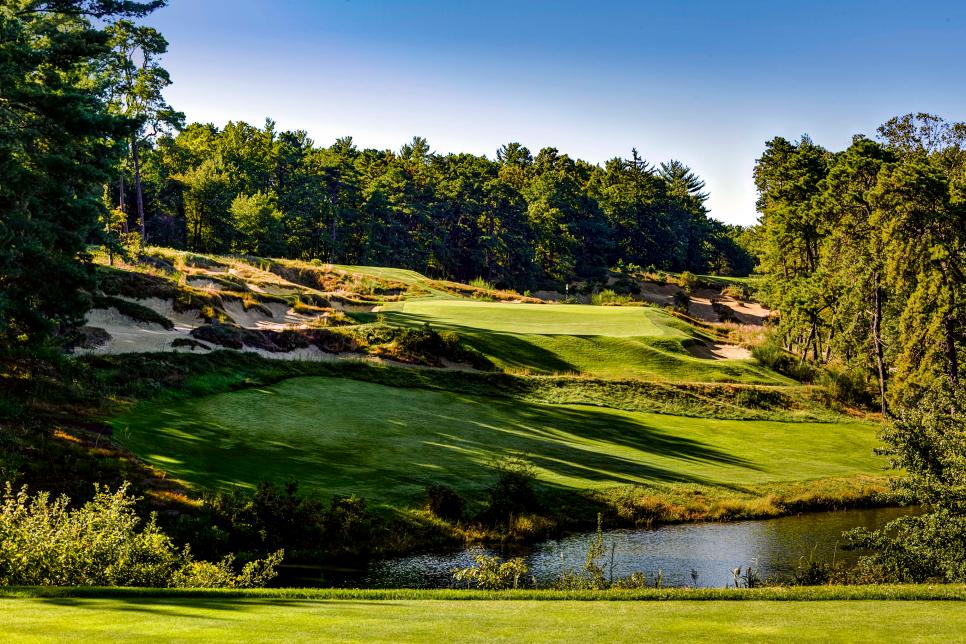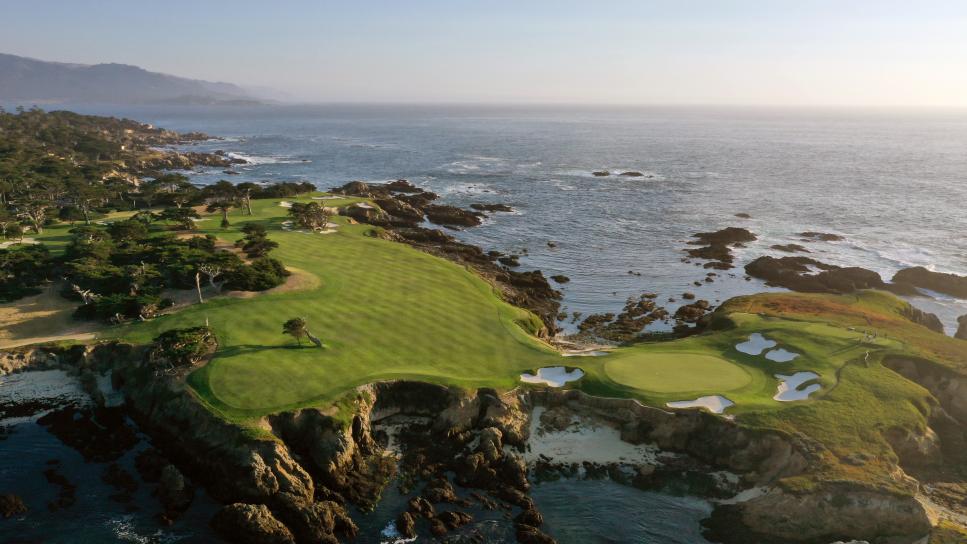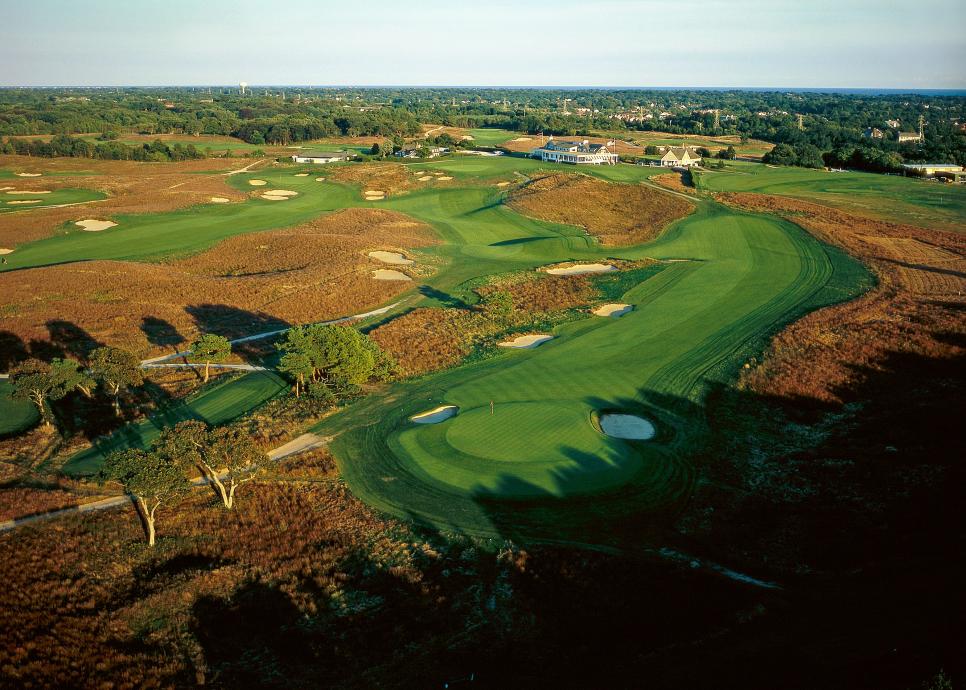In the realm of leisurely pursuits that elegantly blend athleticism with serene landscapes, few can rival the sport of golf. As a testament to this harmonious fusion, the United States offers a tapestry of golf courses that stand as not just places to play, but as hallowed grounds where history, competition, and nature converge. From coast to coast, these courses have witnessed the triumphs and defeats of golfing legends, and they continue to challenge and inspire players of all levels. In the following exploration, we'll immerse ourselves the s In the captivating realm of the top ten golf courses that grace the American landscape, each a testament to the sport's enduring appeal and the pursuit of excellence.
1. Pine Valley
A genuine original, its unique character is forged from the sandy pine barrens of southwest Jersey. Founder George Crump had help from now-legendary architects H.S. Colt, A.W. Tillinghast, George C. Thomas Jr. and Walter Travis. Hugh Wilson (of Merion fame) and his brother Alan finished the job, and William Flynn and Perry Maxwell made revisions. Throughout the course, Pine Valley blends all three schools of golf design—penal, heroic and strategic—often times on a single hole. Recent tree removal at selected spots have revealed some gorgeous views of the sandy landscape upon which the course is routed, and bunker reconstruction by Tom Fazio has given the barrens a more intricate and ornate look.
When it first launched, it had the reputation of being the most challenging golf course ever, and it is still viewed as the most difficult by many. On account of its refined greens and punishing hazards, it’s a definitive test for any expert of the game. For many years,Pine Valley is consistently recognized as America's preeminent golf course.
Course Stats; 7,181 yards, Par 70/Points: 72.1554
![]()
2. Augusta National
No club has tinkered with its golf course as often or as effectively over the decades as has Augusta National Golf Club, mainly to keep it competitive for the annual Masters Tournament, an event it has conducted since 1934, with time off during WWII. All that tinkering has resulted in an amalgamation of design ideas, with a routing by Alister Mackenzie and Bobby Jones, some Perry Maxwell greens, some Trent Jones water hazards, some Jack Nicklaus mounds and swales and, most recently, extensive rebunkering and tree planting by Tom Fazio. The tinkering continues, including the lengthening of the par-4 fifth in the summer of 2018, the lengthening of the 11th and 15th holes in 2022, and the addition of 35 yards to the famed par-5 13th in 2023.
Course stats: 7,475 yards, Par 72/Points: 71.8240
![]()
3. Cypress Point Club
Cypress Point, the sublime Monterey Peninsula work of sandbox sculpture, whittled Cypress and chiseled coastline, has become Exhibit A in the argument that classic architecture has been rendered ineffectual by modern technology.
I'm not buying that argument. Those who think teeny old Cypress Point is defenseless miss the point of Alister MacKenzie’s marvelous design.
MacKenzie relished the idea that Cypress Point would offer all sorts of ways to play every hole. That philosophy still thrives, particularly in the past decade, after the faithful restoration of MacKenzie’s original bunkers by veteran course superintendent Jeff Markow.
Course stats: 6,524 yards, Par 72/Points: 69.9692
![]()
4. Shinnecock Hills
Generally considered to be the earliest links in America, heavily remodeled by C.B. Macdonald, then replaced (except for three holes) by William S. Flynn in the early 1930s, it’s so sublime that its architecture hasn’t really been altered for nearly 50 years. Most trees that once framed many holes have been removed, and in 2012, the team of Bill Coore and Ben Crenshaw did make a few changes, mostly green expansions and new mowing patterns, to prepare Shinnecock for the 2018 U.S. Open, won by Brooks Koepka. Shinnecock will again host the U.S. Open in 2026.
Course stats: 7,445 yards, Par 70/Points: 69.5265
![]()
5. Oakmont
Once tens of thousands of trees (mostly planted in the 1960s) were removed between the early 90s and 2015, Oakmont’s original penal design was re-established, with the game’s nastiest, most notorious bunkers (founder-architect H.C. Fownes staked out bunkers whenever and where ever he saw a player hit an offline shot), deep drainage ditches and ankle-deep rough. Oakmont also has the game’s swiftest putting surfaces, which were showcased during the U.S. Open in 2016, despite early rains that slowed them down a bit. Gil Hanse and Jim Wagner made bunker modifications and expanded the greens throughout the course in 2023 in preparation for the 2025 U.S. Open. The USGA has already awarded Oakmont three additional Opens between 2033 and 2049, reinforcing its title as it the Host of the Most U.S. Opens ever.
Course stats: 7,255 Yards, Par 71/Points: 68.9795
6. Merion Golf Club
Merion East has long been considered the best course on the tightest acreage in America, and when it hosted the U.S. Open in 2013, its first since 1981, the present generation of big hitters couldn’t conquer this clever little course. They couldn’t consistently hit its twisting fairways, which are edged by creeks, hodge-podge rough and OB stakes and couldn’t consistently hold its canted greens, edged by bunkers that stare back. Justin Rose won with a 72-hole total of one-over-par, two ahead of Jason Day and Phil Mickelson. With Gil Hanse's extensive two-year renovation making even more improvements at Merion's East Course, the design should be even more polished when the Open returns again in 2030.
Course Stats: 6,996 Yards, Par 70/Points: 67.6807
7. National Golf Links of America
This is where golf architect Seth Raynor got his start. A civil engineer by training, he surveyed holes for architect C.B. Macdonald, who scientifically designed National Golf Links as a fusion of his favorite features from grand old British golf holes. National Golf Links is a true links containing a marvelous collection of holes. As the 2013 Walker Cup reminded us, Macdonald’s versions are actually superior in strategy to the originals, which is why National’s design is still studied by golf architects today, its holes now replicated elsewhere. Hard to fathom that National Golf Links of America was not ranked in the 100 Greatest from 1969 until 1985.
Course stats; 6,935 Yards, Par 72/Points: 67.3821
![]()
8. Sand Hills
The golf course wasn’t so much designed as discovered. Bill Coore and Ben Crenshaw trudged back and forth over a thousand acres of rolling sand hills in central Nebraska, flagging out naturally-occurring fairways and greens. By moving just 4,000 cubic yards of earth, and letting the winds shape the bunkers, the duo created what is undoubtedly the most natural golf course in America, a timeless course design. For decades, winter winds had always reshaped the bunkers, but course officials have recently discovered a method to prevent that. At the close of the season, they spray the surface of the sand in bunkers with a product that creates a crust to resist the howling winds.
Course stats: 7,089 Yards, Par 71/Points: 66.4208
![]()
9. Fishers Island
Probably the consummate design of architect Seth Raynor, who died in early 1926, before the course had officially opened. His steeply-banked bunkers and geometric greens harmonize perfectly with the linear panoramas of the Atlantic Ocean and Long Island Sound. The quality of the holes is also superb, with all Raynor’s usual suspects, including not one but two Redan greens, one on a par 4.
Course Stats: 6,615 Yards, Par 70/Points: 66.4734
![]()
10. Seminole Golf Club
A majestic Donald Ross design with a clever routing on a rectangular site, each hole at Seminole encounters a new wind direction. The greens are no longer Ross, replaced 50 years ago in a regrassing effort that showed little appreciation for the original rolling contours. The bunkers aren’t Ross either. Dick Wilson replaced them in 1947, his own version meant to the imitate crests of waves on the adjacent Atlantic. A few years back, Bill Coore & Ben Crenshaw redesigned the bunkers again, along with exposing some sandy expanses in the rough. Seminole has long been one of America’s most exclusive clubs, which is why it was thrilling to see it on TV for a first time during the TaylorMade Driving Relief match, and then again for the 2021 Walker Cup.
Course stats: 7,075 Yards, Par 72/Points: 67.3575













